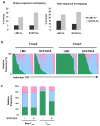Linked T cell receptor and cytokine signaling govern the development of the regulatory T cell repertoire
- PMID: 18199418
- PMCID: PMC2430111
- DOI: 10.1016/j.immuni.2007.11.022
Linked T cell receptor and cytokine signaling govern the development of the regulatory T cell repertoire
Abstract
Appropriate development of regulatory T (Treg) cells is necessary to prevent autoimmunity. Neonatal mice, unlike adults, lack factors required for Treg cell development. It is unclear what these missing factors are. However, signals emanating from the T cell receptor (TCR), the costimulatory receptor CD28, and the family of gammac-dependent cytokine receptors are required for Treg cell development. Herein we demonstrate that expression of a constitutively active Stat5b transgene (Stat5b-CA) allowed for Treg cell development in neonatal mice and restored Treg cell numbers in Cd28(-/-) mice. Sequence analysis of TCR genes in Stat5b-CA Treg cells indicated that ectopic STAT5 activation resulted in a TCR repertoire that more closely resembled that of naive T cells. Using MHCII tetramers to identify antigen-specific T cells, we showed that STAT5 signals diverted thymocytes normally destined to become naive T cells into the Treg cell lineage. Our data support a two-step model of Treg cell differentiation in which TCR and CD28 signals induce cytokine responsiveness and STAT5-inducing cytokines then complete the program of Treg cell differentiation.
Figures






References
-
- Anderson MS, Venanzi ES, Klein L, Chen Z, Berzins SP, Turley SJ, von Boehmer H, Bronson R, Dierich A, Benoist C, Mathis D. Projection of an immunological self shadow within the thymus by the aire protein. Science. 2002;298:1395–1401. - PubMed
-
- Apostolou I, Sarukhan A, Klein L, von Boehmer H. Origin of regulatory T cells with known specificity for antigen. Nature immunology. 2002;3:756–763. - PubMed
-
- Aschenbrenner K, D’Cruz LM, Vollmann EH, Hinterberger M, Emmerich J, Swee LK, Rolink A, Klein L. Selection of Foxp3+ regulatory T cells specific for self antigen expressed and presented by Aire+ medullary thymic epithelial cells. Nature immunology. 2007;8:351–358. - PubMed
-
- Baldwin TA, Hogquist KA. Transcriptional analysis of clonal deletion in vivo. J Immunol. 2007;179:837–844. - PubMed
-
- Bassiri H, Carding SR. A requirement for IL-2/IL-2 receptor signaling in intrathymic negative selection. J Immunol. 2001;166:5945–5954. - PubMed
Publication types
MeSH terms
Substances
Grants and funding
LinkOut - more resources
Full Text Sources
Other Literature Sources
Molecular Biology Databases
Miscellaneous

